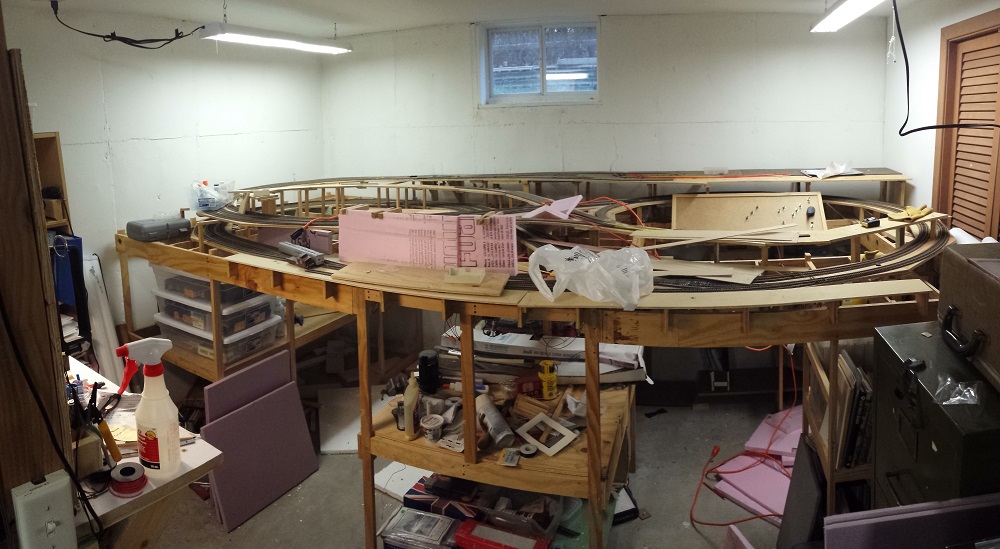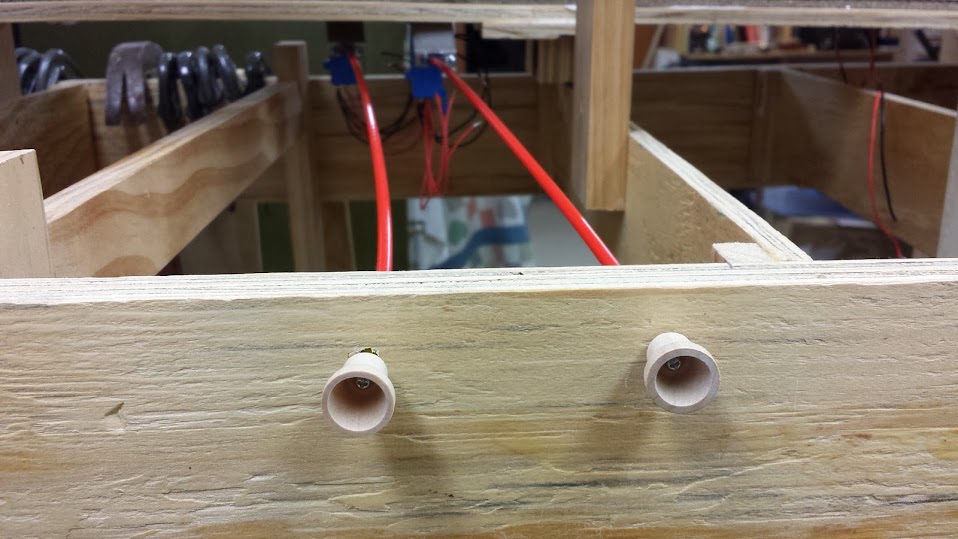revenant
It’s been eighteen months since The Deluge, the plumbing accident that created a virtual monsoon in our basement. As bad as it looked then, and it looked REALLY BAD, quite a lot of our possessions escaped The Deluge unharmed. We had hundreds of books down there, for instance, and almost every one of them survived without water damage.
I started to build the model train layout of my dreams in the basement many years ago. There’s no more to it than the bench and track; I never got to the point where I landscaped it, or built any tiny train stations or other buildings, and a good thing, too. All of that would have been washed away by The Deluge. The track wasn’t affected by the water; it’s still all firmly in place and shows no signs of corrosion. The bench is made of scraps of lumber that doesn’t appear to have warped at all in spite of all the water that washed over it. So essentially the layout is unchanged from the day before The Deluge, presumably in working order.
The room the layout’s in, though, has been a mess ever since.
Two of the overhead light fixtures fell from the ceiling when the water-soaked overhead wallboard panels began to buckle under their own weight and the anchors that held the light fixtures up lost their grip in the sodden panels. Same with the electrical conduit and outlets I screwed to the ceiling to plug the lights into, so there’s been no electrical light in that back corner since The Deluge.
The floor was a scattered mess of scraps of drywall and all kinds of jetsam that got washed off the bench by the floodwaters. Cleanup was such a daunting task I never quite mustered the motivation to get in there with a broom and a vacuum cleaner. It was too depressing to look at, much less think about cleaning up, until last weekend.
It began when I swept a path through the debris wide enough for me to walk in. Then I ran a couple extension cords to the two overhead lights that remained hanging from the ceiling. I crossed my fingers and yanked on the pull chains, not knowing if they still worked. They did. That gave me enough light to keep going.
I pieced together the electrical conduit and outlets that fell from the ceiling. Wouldn’t do any good to hang the lights if I couldn’t connect them to power. Putting the outlets back up was easier than I thought it would be and took less time; I dreaded the idea I might be at it all weekend, but they went up in just a couple hours. I even did it right the first time: The lights came on when I flipped the switch, same as if I knew what I was doing. Always pleasantly surprised when that happens.
With the lights taken care of, I had to get down into the dirt. Literally. There was so much dirt and dust and many, many dead spiders. Lots of broken glass. Bits of wallboard and insulation everywhere. More dirt. It was an unholy mess, and there was nothing to do for it but get down on my hands & knees with the business end of a vacuum cleaner. Kept me busy for the rest of the afternoon.
The next step is to close off the room so the cats won’t be able to get in there. No use wiring the track up again if they’re just going to swipe at the wiring like it’s their favorite new toy. That’s a project for next weekend.


 The awesome power in these little wooden knobs is hard to overstate. Honestly. I wouldn’t bullshit you about something as serious as that. Or about the fact that I wouldn’t bullshit you. Which is bullshit, and I’m sure you know it.
The awesome power in these little wooden knobs is hard to overstate. Honestly. I wouldn’t bullshit you about something as serious as that. Or about the fact that I wouldn’t bullshit you. Which is bullshit, and I’m sure you know it.  Then I spent all afternoon in the basement throwing crap out, putting away the stuff I couldn’t make myself throw out, and finally knocking together a work bench where I could work on choo-choo trains. I used to make a temporary work bench by throwing a board across an open stretch of the layout, but there aren’t any open stretches any more, and I still needed a place to solder track together or whatever.
Then I spent all afternoon in the basement throwing crap out, putting away the stuff I couldn’t make myself throw out, and finally knocking together a work bench where I could work on choo-choo trains. I used to make a temporary work bench by throwing a board across an open stretch of the layout, but there aren’t any open stretches any more, and I still needed a place to solder track together or whatever. 

 Motive power on the Lost Continent Railway is a hash of electric, diesel and steam. Until I started building the layout in its current incarnation I wasn’t sure what era I wanted my railroad to look like, so for the longest time I collected just about anything that came along at the right price. Later I realized that the locomotives I most loved watching were steam engines and the passenger cars that were most interesting were the old heavyweights, and that’s what I’ve gravitated towards these past years. Yet I still have all sorts of motive power in the engine shed and so far haven’t been able to bring myself to part with any of it.
Motive power on the Lost Continent Railway is a hash of electric, diesel and steam. Until I started building the layout in its current incarnation I wasn’t sure what era I wanted my railroad to look like, so for the longest time I collected just about anything that came along at the right price. Later I realized that the locomotives I most loved watching were steam engines and the passenger cars that were most interesting were the old heavyweights, and that’s what I’ve gravitated towards these past years. Yet I still have all sorts of motive power in the engine shed and so far haven’t been able to bring myself to part with any of it.